

List of Uncommon Cold Hardy Fruit Trees (Gardening Zones 3-7) – 30 Bananas a Day! The hardiest fruit trees are Apples, Pears, and Plums which survive Zone 3 temperatures (-30 degrees to -40 degrees Fahrenheit).

In Zone 4, many varieties of berries, Plums, Persimmons, Cherries, and Apricots do very well. In Zone 5 there are more options such as Peaches, Mulberries, and Paw paws. These zones receive temperatures as low as 20 or 30 degrees below. Fortunately I can grow more types of fruit in my gardening zone 6 and 7. Zone 6 receives temperatures of 0 degrees through -10 degrees F during the Winter while Zone 7 receives temperatures of 10 degrees through 0 degrees F. Because I have listed below Fruits I can grow for my area, you may want to investigate each fruit for your area. Apples are the most common Fruit trees I see growing in my community. I did not want to focus on the most common Fruits, however. Chinese JujubeZiziphus jujuba "Jujube grows throughout most of the southern half of North America. Figs In the Northern Winter - Life in the Fast Lane Blog. Why do we gardeners love a challenge?

What is it about us, that when we read ‘hardy to zone 7’ or ‘8a’ or whatever, we immediately think, ‘Oh really? That can’t mean me. Not here. I can grow that, surely that can’t apply to my backyard?” Intertribal Timber Council : Welcome. Welcome to the Intertribal Timber Council web page.
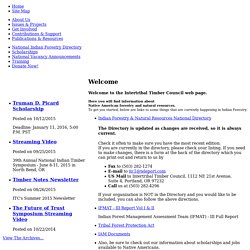
Here you will find information about Native American forestry and natural resources. To get you started, below are links to some things that are currently happening in Indian Forestry. Indian Forestry & Natural Resources National Directory The Directory is updated as changes are received, so it is always current.Check it often to make sure you have the most recent edition. If you are currently in the directory, please check your listing. Chelsea Green Publishing - Pawpaw. Vermont-based master butcher Cole Ward delivers a comprehensive guide to whole-animal butchery that goes beyond conventional “do-it-yourself” books and takes readers inside the world of truly sustainable meat production.

The Gourmet Butcher's Guide to Meat demystifies the process of getting meat to the table, and its wide scope will be welcome to those who not only wish to learn the rudiments of butchery, but also want to understand how meat animals are raised, slaughtered, and marketed in a holistic system that honors both animals and consumers. Written in Cole’s unique voice of humor and simplicity, the book celebrates the traditional art of culinary butchery, introducing readers to stand-out butchers in America and Europe as well as a diverse group of farmers committed to raising the very best animals with respect.
Top 5 Manual Log Splitters. Fire in America: A Cultural History of Wildland and Rural Fire by Stephen J. Pyne. EDIBLE LEAF MULBERRY TREE. The type of fertilizer you choose may be chemical or organic.
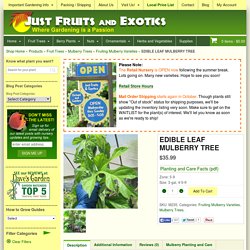
Make sure that the fertilizer contains iron, zinc, manganese, magnesium, molybdenum, copper and boron. These minor elements are very important to plants and most soils are low in these elements. Application rates vary according to age of plant. See chart below. Spread the fertilizer evenly under the entire canopy of the plant avoiding a 5-inch area around the trunk. Bearberry (Arctostaphylos uva-ursi) : Prairie Nursery : Native Plants. Foraged Flavor: Finding Fabulous Ingredients in Your Backyard or Farmer's Market, with 88 Recipes by Tama Matsuoka Wong. Wild Berries & Fruits Field Guide: Minnesota, Wisconsin and Michigan by Teresa Marrone. Bog bilberry (Vaccinium uliginosum) Bog bilberry - Wild Huckleberry Lovers. Vaccinium uliginosum Bog Bilberry PFAF Plant Database.
Alpine Bilberry, Bog Bilberry, Ground Hurts Vaccinium uliginosum. Trees for Gardens, Orchards and Permaculture. This beautifully presented book covers over 100 useful trees from commonplace fruit such as apples and pears to the exotic sounding date plum and golden chinkapins.
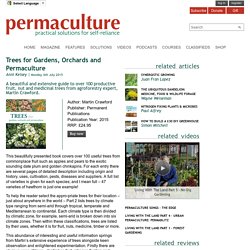
For each entry there are several pages of detailed description including origin and history, uses, cultivation, pests, diseases and suppliers. Dirt On Gardening: 15 Fruit-Tree Pruning Tips. Jessica Walliser Pruning is as much art as it is science—and never more so than it is in the orchard.

Proper fruit-tree pruning is a deciding factor in both fruit production and tree health. While taking a hands-on pruning course from an experienced orchardist is always your best bet, here are some tips for successful fruit tree pruning. Fruit tree pruning should take place in late winter or early spring, when the tree is dormant and you can see the framework of the branches. Summer pruning is only necessary when removing dead or diseased branches or to remove suckers from the base of the tree.
. « More Dirt on Gardening » Uncommon fruit. 6 Permaculture Power Plants. Build a lasting and vital garden by including these plants into your permaculture guild.
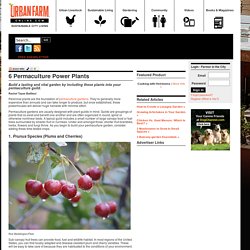
Rachel Tayse Baillieul Perennial plants are the foundation of permaculture gardens. Seckel Pear - Pear Trees - Stark Bro's. Agroforestry - Kerr Center. Viburnum alnifolium Hobbleberry. Viburnum prunifolium (Stagberry) - Practical Plants. Viburnum prunifolium Stagberry, Black Haw, Hybrid blackhaw, Smooth Blackhaw, Blackhaw Viburnum PFAF Plant Database. Plants For A Future can not take any responsibility for any adverse effects from the use of plants.
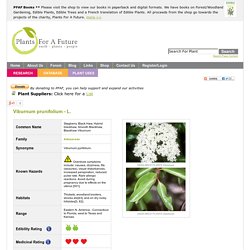
Always seek advice from a professional before using a plant medicinally. Abortifacient; Anodyne; Antispasmodic; Astringent; Birthing aid; Nervine; Sedative. Stagberry was used by the North American Indians to treat dysentery and to arrest haemorrhage of the uterus[254, 257]. It is now considered to be a specific treatment for the relief of menstrual pain - the bark contains 'scopoletin', a coumarin that has a sedative affect on the uterus and salicin, a painkiller that is used in making aspirin[238, 254].
Search results for "the uses of wild plants" (showing 1-12 of 12 books) Edible Forest Gardens Home. Northern Nut Growers Association. Uncommon fruit. UW ext. Uncommon Fruit. History and background Dormant jostaberry Jostaberry is a complex ribes hybrid of the European currant (Ribes nigrum) and gooseberry (Ribes sup).
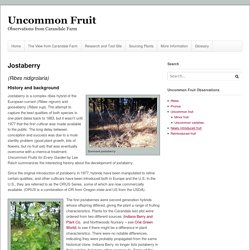
The attempt to capture the best qualities of both species in one plant dates back to 1883, but it wasn’t until 1977 that the first cultivar was made available to the public. The long delay between conception and success was due to a mule sterility problem (good plant growth, lots of flowers, but no fruit set) that was eventually overcome with a chemical treatment. Uncommon Fruits for Every Garden by Lee Reich summarizes the interesting history about the development of jostaberry. Quinces Cornell University. Quinces are small, irregularly shaped trees growing to about 15 feet tall that are often used as rootstock for dwarf pears. They bear white or pink showy flowers at the ends of leafy shoots in spring. Beach plum, sand cherry Cornell University. Beach plums are stone fruits, related to other plums, cherries and peaches. Plants grow 4 to 10 feet tall and produce a profusion of white or pink flowers in mid-May, later than most other stone fruits.
Cornelian cherry, Cornell University. This small, upright to spreading, 15- to 20-foot-tall tree bears small yellow flowers very early (in late winter or early spring) before leaves develop. Flower buds are conspicuous and attractive in winter, and the bark is flaky, exfoliating and gray-brown to brown. Foliage turns purplish-red in fall. The fruits, about the size and shape of a medium-sized olive, ripen to a dark reddish-maroon in late summer. Juneberry, Cornell University. The fruit is technically a pome (like and apple), not a berry. These small trees grow up to 25 feet tall and are very attractive, with plentiful white flowers blooming in late April to early May, usually showing before the fine-textured leaves fully develop.
Juneberries have attractive gray bark, an upright branching habit that becomes horizontal with age, and showy red fall foliage. Use a dark background to emphasize these fine landscaping qualities. The fruits are ¼ to 3/8 inch in diameter, and fleshy red, turning purplish-blue to black. Pawpaw, Cornell University. Pawpaws are small deciduous trees that are hardy in Zones 5 to 8 and usually grow 15 to 20 feet tall (up to 40 feet under ideal conditions). They are attractive, with large, showy leaves and a pyramidal shape. Sometimes suckers form creating a pawpaw thicket. Persimmons Cornell University. This attractive tree can grow up to 30 feet tall. Elderberry Cornell University. Hardy kiwi, Cornell University. While their tastes are similar, hardy kiwifruits are different from the kiwifruits you find in the produce aisle at the supermarket. The hardy kiwifruit (Actinidia arguta) is native to northeastern Asia, while its commercially available cousin (A. chinensis) is native to southern China.
In the eastern United States, the commercial kiwifruit grows only as far north as Maryland and then only in protected spots. Currants Gooseberry Fruit Resources, Cornell University. Although many people today are unfamiliar with these fruits, New Yorkers grew 2,700 acres of them in the 1920s. Currants and gooseberries in the home garden. Youngberry Plant Care & Growing Information.
Buy Boysenberry Bushes from GrowOrganic.com. How to grow Boysenberries: A guide to choosing, planting, training and looking after Boysenberries. Dewberry - Rubus c. 'Austin' at eBurgess.com. Buffalo berry American Indian Health - Health. Buffalo berry Fruit Cornell University. Buffalo-berry Farm. Hardy Almond Trees. Chainsaw safety course.
Mashua* (Tropaeolum tuberosum) potted plant, organic. Mashua (Tropaeolum tuberosum) Andean Tuber Crops » Sacred Succulents. Mulberries - Fruit Trees Online from Bay Laurel Nursery. Tree Crops, A Permanent Agriculture by J Russel Smith pdf. Tree Crops: A Permanent Agriculture by John Smith. Ambrosia apples for sale. 22 trees that can be tapped for sap and syrup. Edible Pine Nut Trees - Rhora's Nut Farm & Nursery. Sweet Flag. Acorus calamus... d8620. Autumnolive. Integrated Forest Gardening: The Complete Guide to Polycultures and Plant Guilds in Permaculture Systems by Wayne Weiseman. How To Make Pine Pitch Glue Primative Skills. Integrated Forest Gardening: The Complete Guide to Polycultures and Plant Guilds in Permaculture Systems by Wayne Weiseman.
Farming the Woods: An Integrated Permaculture Approach to Growing Food and Medicinals in Temperate Forests by Ken Mudge. Eric Toensmeier Edible Forest Garden Workshop (1/3) Green Nature/Human Nature: THE MEANING OF PLANTS IN OUR LIVES by Charles A. Lewis. The Encyclopedia of Edible Plants of North America by François Couplan. The Nature of Plants: Habitats, Challenges, and Adaptations by John Dawson. The Secret Teachings of Plants: The Intelligence of the Heart in the Direct Perception of Nature by Stephen Harrod Buhner. Carts and Tools - Exceptional farm and garden tools.
State Search Results. Watch What Happens When Tribal Women Manage India’s Forests. Forest Farming with Steve Gabriel. Growing Crops Within the Canopy of an Existing Forest. (PVP094) Agroforestry for Sustainability: An Online Resource Collection: ForestryDegree.net. The Overstory Book (2nd Edition) De-slugging the Woods: Maple-mushroom-duck polyculture proving to be ecological, economical, and enjoyable for the farmers. Wellspring Forest Farm. Lexicon of SustainabilityThe Food List: Biodynamics.
Ginkgo Tree for Sale. Nature Hills Nursery. About WisCorps. Gander Mountain Academy / Fire Arms Training / Wisconsin Concealed Carry Weapons License. UW-Madison Center for Integrated Agricultural Systems. S Garden: Pseudotsuga menziesii var menziesii. Arthur Haines. My Wisconsin Woods. Southwest Badger RC&D Council Reforestation Aids - Home. Wisconsins Driftless Area Forest Foundation.